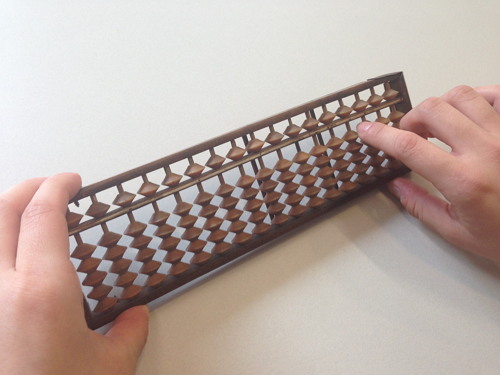Jupan, a time-honored form of calculator also known as the abacus, is reemerging in South Korea as an analog tool to sharpen mental acumen in the era of digital distraction.
The abacus was first presented as drawings of circles by Babylonians around B.C. 3000. It was later modified into the shape we know now ― the rectangular wooden frame and beads strung up on metal rods ― by the Chinese in A.D. 1300, who called it “suanpan.” Koreans adopted it in 1400 under the name “jupan.” By visualizing numbers with beads, this analog tool made complex calculations possible for clerks and merchants before the age of digital calculators.
Jupan continued to exist as a useful tool in modern times, as it enabled its users to picture the beads in mind and perform quick mental calculations.
The abacus was first presented as drawings of circles by Babylonians around B.C. 3000. It was later modified into the shape we know now ― the rectangular wooden frame and beads strung up on metal rods ― by the Chinese in A.D. 1300, who called it “suanpan.” Koreans adopted it in 1400 under the name “jupan.” By visualizing numbers with beads, this analog tool made complex calculations possible for clerks and merchants before the age of digital calculators.
Jupan continued to exist as a useful tool in modern times, as it enabled its users to picture the beads in mind and perform quick mental calculations.

“Becoming familiar with jupan not only improves the right hemisphere of the brain that helps people to think about problems step by step, but also the left side that is related to creativity, as people get to mentally visualize the arrangement of beads as they calculate.” said Lee Young-ha, a professor at the Department of Mathematics Education at Ewha Womans University.
“In addition, as the beads on jupan are tiny and easily moved along the wire, one has to pay close attention while moving them, which ultimately leads to the improvement of concentration.”
Supported by expert opinions, a recent phenomenon has arisen in South Korea, in which jupan is regaining newfound popularity as an effective means to cultivate the minds of young people, who are over-dependent on digital technology.
Kim Soon-hi, the head of the Korea Association Zhoushan’s Gangnam branch, singled out the advanced digital tools of today as the cause behind young children’s lack of concentration, perseverance and arithmetic dexterity.
“Digital calculators and computers don’t require thinking. Kids from younger generations are inundated by this on-hand technology. Many of them even fail to learn their home phone numbers by heart,” she said.
“In the 1970s and ’80s the ability to calculate with jupan was a prerequisite for anyone who wished for a career in business,” Kim said. “But now, jupan is primarily used as an educational tool.”
“Older people do it too as ‘brain sports’ that help prevent dementia.”
The number of people paying attention to the benefits of jupan has consistently increased, Kim said. As a result, the once-bimonthly supan certification exam is now carried out every month as of this year.
The number of students who took the certification test doubled in February to over 1,000, compared to the 450 in January.
Kim, a veteran jupan instructor at Seoul National University of Education, said she hoped for more people to recognize the benefits and potential of jupan.
By Lim Jeong-yeo and Hong Hye-jin
(kaylalim@heraldcorp.com) , (honghyejin@heraldcorp.com)
-
Articles by Korea Herald







![[Graphic News] More Koreans say they plan long-distance trips this year](http://res.heraldm.com/phpwas/restmb_idxmake.php?idx=644&simg=/content/image/2024/04/17/20240417050828_0.gif&u=)
![[KH Explains] Hyundai's full hybrid edge to pay off amid slow transition to pure EVs](http://res.heraldm.com/phpwas/restmb_idxmake.php?idx=644&simg=/content/image/2024/04/18/20240418050645_0.jpg&u=20240419100350)






![[From the Scene] Monks, Buddhists hail return of remains of Buddhas](http://res.heraldm.com/phpwas/restmb_idxmake.php?idx=652&simg=/content/image/2024/04/19/20240419050617_0.jpg&u=20240419175937)

![[KH Explains] Hyundai's full hybrid edge to pay off amid slow transition to pure EVs](http://res.heraldm.com/phpwas/restmb_idxmake.php?idx=652&simg=/content/image/2024/04/18/20240418050645_0.jpg&u=20240419100350)

![[Today’s K-pop] Illit drops debut single remix](http://res.heraldm.com/phpwas/restmb_idxmake.php?idx=642&simg=/content/image/2024/04/19/20240419050612_0.jpg&u=)